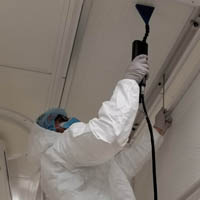FAQs
Why is Helium Tracer Gas Leak Detection the preferred method for finding small leaks is piping, vessels and components?
Helium is one of the smallest atoms, it can go through holes better than larger atoms and molecules. It is inert, so it is not harmful to people or equipment. The concentration of helium in air is very low, so there is little interference in the test from ambient air. The test is non-destructive. The test is rapid and reproducible. It works over 9 orders of magnitude.
Are dry pumps superior to oil sealed pumps?
The seal in a dry pump is a small gap between the rotor and the stator. As such there is always an air gap in the pump. It is the motion of the rotor that keeps air from rushing back inside the pump through that small gap. This limits the base pressure that is achievable, compared to an oil sealed pump. But the vacuum produced by a dry pump will be completely free of hydrocarbon vapor. A dry pump costs about twice as much as similar oil sealed pump. There is no oil to dispose of.
An oil sealed pump used oil to seal the rotor and stator. The base pressure of an oil pump is lower than a comparable dry pump. An oil sealed pump will typically run longer between service activities. The used oil must be disposed of.
Do vacuum pressure gauges measure pressure?
Below a pressure of 1e-4 mbar, pressure gauges that measure the force of air against a mechanical device don’t work. To measure the pressure below that your must measure a physical property that is related to pressure. Typically this is the ionization potential (Hot Cathode or Cold Cathode) of the gas or the thermal conductivity (Pirani Gauges).
Ralph Kraft
Specialties:
Consulting, 3rd Party Certification Training, ISO 17025 Accredited
Reggie Ulrich
Specialties:
Navac Vacuum Pump Supplier
Helium tracer gas leak detection
Residual gas analysis
Vacuum problem solving
Terry Rogelstad
Specialties:
Navac Vacuum Pump Supplier
Helium tracer gas leak detection
Residual gas analysis
Vacuum problem solving





